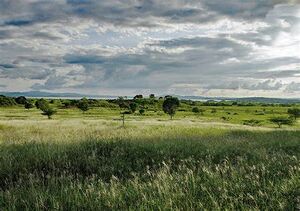Battle of Pais au DuBord
This article is incomplete because it is pending further input from participants, or it is a work-in-progress by one author. Please comment on this article's talk page to share your input, comments and questions. Note: To contribute to this article, you may need to seek help from the author(s) of this page. |
| Inyurstan Civil War | |||||||
|---|---|---|---|---|---|---|---|
| |||||||
| Belligerents | |||||||
|
| Template:Country data commieinyursta AVI | ||||||
| Commanders and leaders | |||||||
|
|
Template:Country data commieinyursta Generále Luis-Vega Machaude | ||||||
| Strength | |||||||
|
x6,450 Troops |
x8,200 soldiers | ||||||
| Casualties and losses | |||||||
|
| ... | ||||||
The Battle of Pais au DuBord was a large engagement in the Inyurstan Civil War, considered by many to be a major "turning point" in the war. It was also notable for being the largest armored engagement of the conflict, and until the 2006 Battle of Nun's Glade the most successful armored operation in Inyursta's history.
Background
Despite the progress of the last three years of the conflict, Colonel Enrique Javez the de-facto leader of forces in Marindino, was facing both international and internal pressure to prove that his army was capable of "escalating" from a guerrilla war into a conventional war. Javez sought to demonstrate that his faction could not only capture territory and cities, but also command a standing army capable of defending whatever gains they might have when the war ends.
Prior to the operation, Javez's right-hand man in the western foothills of the Sierra Miraco Jean-Lupo Pascèses, had spent months studying the reaction tactics of AVI forces in Marindino, using "probing" skirmishes in a variety of different localities and formations to gain an idea of the enemy's doctrine. He had also pitched the hunch to Javez that enemy tank forces were not well trained or experienced in combat - or well equipped for night operations. Pascèses's regiment had tanks of their own, which had taken them weeks - if not months - to properly understand and utilize; while the enemy was seemingly rolling tanks off of foreign ships and right into contested cities. Other ACRI commanders cautioned against this assumption, believing that this was due to the enemy using foreign tank crews. Javez, under pressure, ultimately decided to trust Pascèses.
Planning for the Battle
By January 1961 it had become apparent that, despite the optimistic wishes of Carmòn Solévereu, the AVI would be hard-pressed to both lay siege to Cordoba and relieve the defenders of Fjorda de Rivera. Counter-revolutionary aligned spies had indicated that Solevereu was still pushing for a "relief corridor" between both cities, and soon after the intel would be confirmed by offensives from both the western side of Fjorda and the easternmost forces encircling Cordoba that they were trying to link up in the "prairie corridor" - a series of semi-flat grasslands dominating the table top slopes at the foothills of the mountains. With internal politics and external pressure mounting, Javez realized this would be his chance to hopefully engage and destroy an enemy army group in the field.
Part 1: Contact & Deception
Gèreudán's
The Miracle of Larou
Unbeknownst to Javez and his officers, a skirmish in the otherwise irrelevant coastal town of Larou would sway the battle in their favor. [skirmish info here] The event was known as "The Miracle" because, while false information being passed up the chain in the AVI was common, overly negative false information was unheard of. Typically, AVI commanders would report overly optimistic assessments of their progress, which would then become more optimistic as they went up the chain - often resulting in reinforcements or resupply not reaching embattled forces; in the case of Larou, the negative assessment became more negative as it went up the chain. Machaude, used to a level of optimistic dishonesty had no reason to suspect that reports of a massive counter-revolutionary assault on the coastal axis was overblown and falsified. Generále Luis-Vega Machaude, now confident that what the forces at Pais au DuBord were encountering was a smaller grouping rather than a vanguard for Javez's main force, made a fatal mistake and cleared Colonel Olifanyé to commit his QRF.
Egalisa de Sant Patricio
With the pro-government reserves now entering the fight (and with them mobile, armored vehicles), the soldiers of the Pradiera Brigade began evacuating the wooded knoll. The plan had always been to incrementally fall back, drawing the AVI forces further and further from the main road; however, in a small rural hamlet the ACRI forces continued fighting longer than was to be expected, with a number holding out in and around a small church. Whether this was due to Gèreudán understanding and supporting Javez's desire for a propaganda victory in addition to a physical one (or perhaps wanting his own glory & recognition), or due to the fact that the Pradiera Brigade was recruited from the foothills and grasslands south and southeast of Cordoba and found sentimental value in defending the church is still a matter of debate.
